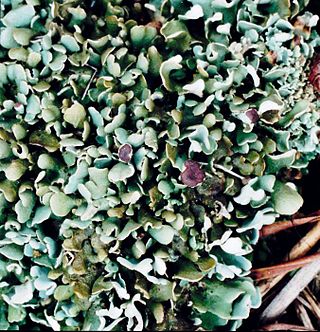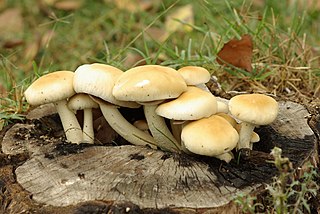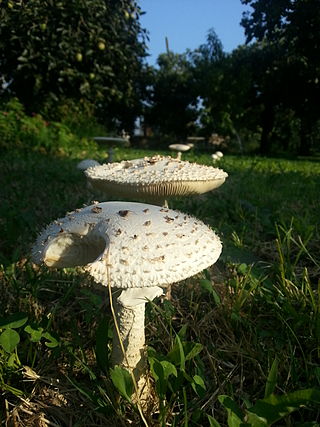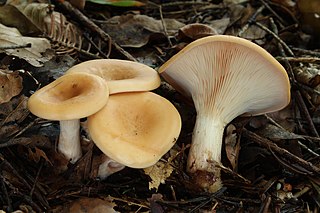
Lecanoromycetes is the largest class of lichenized fungi. It belongs to the subphylum Pezizomycotina in the phylum Ascomycota. The asci of the Lecanoromycetes most often release spores by rostrate dehiscence.

The Crepidotaceae are a family of basidiomycete fungi.

The Serpulaceae are a family of fungi in the Boletales order. According to the Dictionary of the Fungi, the family contains 4 genera and 20 species. However, a molecular phylogenetics study showed that the genus Neopaxillus, which was formerly placed in this family, belongs in the family Crepidotaceae in the order Agaricales.
Neopaxillus is a genus of fungi in the family Crepidotaceae. According to the Dictionary of the Fungi, the family contains five species found in Central and South America; a sixth, N. dominicanus, was reported in 2011. It was formerly considered to belong in the family Serpulaceae in the order Boletales, but molecular analysis showed that Neopaxillus is better placed in the Agaricales as a sister group to Crepidotus.

Cyclocybe aegerita, also called Agrocybe cylindracea, Agrocybe aegerita or Pholiota aegerita, is a mushroom in the genus Cyclocybe which is commonly known as the poplar mushroom, or velvet pioppini. In Japan, it is called Yanagi-matsutake (柳松茸).

Volvopluteus michiganensis is a species of mushroom in the family Pluteaceae. It was originally described under the name Pluteus michiganensis but molecular studies have placed it in the Volvopluteus, a genus described in 2011. The cap of this mushroom is about 7–9 cm (2.8–3.5 in) in diameter, gray, and has a cracked margin that is sticky when fresh. The gills start out as white but they soon turn pink. The stipe is white and has a volva at the base. Microscopical features and DNA sequence data are of great importance for separating this taxon from related species. V. michiganensis is a saprotrophic fungus that was originally described as growing on sawdust. It has only been reported from Michigan (USA) and the Dominican Republic.

Saproamanita nauseosa is a species of agaric fungus in the family Amanitaceae. First described by English mycologist Elsie Maud Wakefield in 1918 as a species of Lepiota, it was named for its nauseating odor. The type specimen was found growing on soil in the Nepenthes greenhouse at Kew Gardens. Derek Reid transferred the species to Amanita in 1966, and then in 2016 the separate genus Saproamanita was created by Redhead et al. for saprophytic Amanitas and it was transferred to this new genus.

Caloboletus is a fungal genus in the family Boletaceae. It was circumscribed by Italian mycologist Alfredo Vizzini with Caloboletus calopus as the type species. The erection of Caloboletus follows recent molecular studies that outlined a new phylogenetic framework for the Boletaceae. Boletus peckii was also transferred to this genus by Vizzini, but was subsequently moved to the genus Butyriboletus based on molecular evidence. The generic name Caloboletus, derived from the Greek calos "nice", refers to the attractive red coloring of the stipe.

The genus Saproamanita contains about 24 species of agarics and is one of six genera in the family Amanitaceae. The others are Amanita, Catatrama, Limacellopsis, Zhuliangomyces and Limacella. Saproamanita are the saprophytic species in the Tribe Amaniteae, separately classified from the ectomycorrhizal species in the genus Amanita.

Paralepista is a genus of mushrooms in family Tricholomataceae. Until 2012, its member species were generally assigned either to Lepista or to Clitocybe.

Cyclocybe parasitica, also known as tawaka in Māori language or poplar mushroom, is a species of gilled mushroom in the genus Cyclocybe found mostly in New Zealand and Australia. It grows on native and introduced trees where it can cause heart rot, and does not seem to be associated with conifers.
Leucocoprinus domingensis is a species of mushroom producing fungus in the family Agaricaceae.
Leucocoprinus parvipileus is a species of mushroom producing fungus in the family Agaricaceae.
Leucocoprinus tephrolepis is a species of mushroom producing fungus in the family Agaricaceae.










